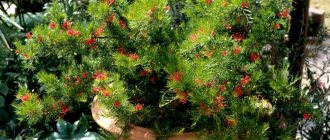Ruscus , also called butcher's broom , is directly related to the asparagus family (Asparagaceae). However, there are sources in which this plant is allocated to its own family, Ruscaceae, or it is included in the family called Liliaceae.
Such a domestic perennial plant as butcher's broom has a very impressive appearance. It is distinguished by its non-capricious character and undemanding care. Can grow in shaded areas. Most often, flower growers grow ruscus as a compact bush, but it can also be decorated as a lovely Christmas tree. During fruiting, almost the entire plant is covered with round berries of a rich red color. Since this flower is unpretentious, it is often chosen to decorate not only apartments, but also offices. The rigid stems of this flower are dark green. After cutting, they do not lose their spectacular appearance for many months, so ruscus is quite suitable for composing various compositions.
In the wild, broom can be found in pine and oak forests of Western Europe, Crimea, the Caucasus, and also in the southern part of Russia.
This flower can grow up to 70 centimeters. Spear-shaped, spiny leaves are nothing more than modified flat stems, which experts call cladodes (phyllocladies). The scaly leaves are very small in size.
In spring, flowering begins, but the rather inconspicuous flowers do not represent any decorative value. However, berries appear from pollinated flowers, which, after ripening, acquire a rich red or orange-red color. The fruits do not fall for a long time. Therefore, the same bush can contain both flowers and fruits. As a result, you may get the impression that the butcher's broom is constantly blooming and bearing fruit. For fruit to appear, female and male plants are needed. But often fruits can also form on butcher's broom, which grows alone.
Butcher's broom ruscus Home care
About the plant
Iglitsa has the second name Ruskus. Different types of butcher's broom vary in height and appearance. The shrub by nature does not shed its leaves every year. The leaves are not really leaves, they are shoots, and the actual leaves are small and like scales.
The butcher's broom is decorated with its berries, but it is extremely rare to see them at home, they rarely appear at home, they are pollinated by insects, after which a red berry appears.
Habitat
In the wild, the shrub can be found in Western Europe, where it grows in juniper and pine forests, next to rocks. In addition, butcher's broom loves to coexist with hornbeams and oaks. Some species of this plant grow in Asian and African countries. The habitat of Pontic broom in our country is the woody areas of the Crimea and the Caucasus. It should be noted that this plant is listed in the Red Book and is under state protection.
How to care
Ruscus is used for landscaping garden plots and squares. It is a misconception that a houseplant is difficult to care for, that it requires some special care and attention, let's see if this is actually true.
Before you start caring for butcher’s broom at home, you need to familiarize yourself with some rules, which will include several points:
What kind of light should there be? This plant feels better when there is little sun, which means it needs to be placed in the shade. In winter, it is best, if possible, to place it on a windowsill facing south. In hot weather, it is recommended to place it in a darker place, because direct sunlight can damage the leaves.
What should the air humidity be? In spring and summer, you need to maintain the temperature in the range of 18-20 degrees. The temperature decrease should occur in the fall. In winter it should vary from 13 to 15 degrees.
The plant can easily tolerate drafts and temperature changes. You don’t have to pay much attention to the humidity in the room, because this type of plant tolerates dry air well.
How to water a flower - when the growing season occurs, you need to monitor constant watering, flowers can usually be watered infrequently, and before shoots begin to appear, systematically, when they form, you can reduce the amount of watering. It is necessary not to overdry the soil.
How to fertilize - during the winter season, the broom is dormant and there is no need to fertilize; fertilizers must be available and applied to the soil from spring to late autumn.
What the soil should be like - not too dense a substrate, this can lead to water accumulation.
Signs and superstitions
Dracaena is a plant that brings good luck, success and material wealth. According to the teachings of Feng Shui, dracaena should be placed at the entrance.
Dracaena - a talisman for good luck
What exactly Marginata will bring to its household will be determined by the number of leaf plates on it:
- attracting happiness and good luck - 3 pcs;
- good health - 7 pcs.;
- financial well-being - 5 pieces.
Dracaena is a plant amazing in its properties and characteristics. Despite the fact that in conditions of “captivity” it extremely rarely throws out inflorescences, you can still see delicate white balls if you create comfortable living conditions for the plant.
Growing, transplanting
Growing at home does not require much difficulty or effort. You just need to adhere to the rules that are written above, they will not allow you to make mistakes in the process of caring for butcher's broom and it will delight the eye with its beautiful appearance.
What do you need to know when growing this plant? First of all, you need to know how to transplant correctly and know how these plants reproduce.
In order for your plant to grow into a wonderful flower, it is better to replant in the spring; this time of year is the most successful and favorable for butcher's broom. It is worth replanting when the plant has grown too much, and the size of the pot in which the replanting will take place must be adjusted to the size of the current one.
If you don’t want the bush to have fluffiness as a decoration, then choose a narrow pot. To prevent water from stagnating during irrigation, it is recommended to make the bottom layer from drainage. Feeding should be done once every three weeks.
Reproduction
Butcher's broom reproduces using rhizomes and seeds.
Butcher's broom seeds should be placed in a container with water, glass should be placed on top, and placed in a lighted place. The first sprouts will appear in 2-3 months, the first fruit in a year. You can also do the second propagation method with seeds.
To do this, the seeds are placed in a special mixture of peat and perlite and placed in a room where the air is 20 degrees. Planting into separate pots should be done if they have grown to their maximum capacity.
Dividing the rhizome is most favorable; it helps with strong plant growth, in which it is difficult to continue development further. To do this, they cut it with a sharp knife, dividing it into parts, pieces that have many shoots and a root system.
With this type of propagation, transplantation should occur in autumn or spring, at which time it does not grow so quickly. When replanting, you need to avoid quick and careless movements; they can aggravate the situation and harm the growing shoots.
Diseases, pests
Ruscus is afraid of 4 types of pests:
- Mealybug.
- Spider mite.
- Thrips.
- Scale insects.
Pests can be identified by white dots. Mealybug due to dried leaves and lethargy of the plant.
You can control pests as follows:
- Garlic infusion . 2 heads of garlic are poured into 1 liter of water and left for 5 days. The infusion is diluted in water in a ratio of 1 to 1.
- Medical alcohol . Just wipe the leaves.
- Fitoverm . A modern drug that needs to be used to treat the plant.
But a separate drug can be used for each pest. For example, Tsvetofos works well against mealybugs, and Fufanon works well against scale insects.
Ruscus is practically not susceptible to disease. Just fertilize it in a timely manner and it will develop resistance to diseases.
Usually there are no problems with care. If the broom grows slowly, it needs to be watered, fed and exposed to light more often. And if it turns yellow, it is better to put it in the shade.
Benefit
Ruscus bush is now widely used for many diseases. Creams, ointments, and gels are made from the plant. They are especially used in medicine; creams are very effective in dilating veins.
Traditional medicine also uses this type of plant, the rhizome and fruits of butcher's broom are beneficial, the berries are used in treatments for jaundice, the rhizome is used for infusions that eliminate headaches, gout, relieve swelling, and relieve gangrene.
In alternative medicine, they have taken a broader approach to using the plant, for example, it is a binding element in the production of drugs, the medicinal properties of ointments and creams. The fruits of the bush also help purify the blood.
Kinds
Here we present the types of butcher's broom plant; we will describe the plant itself and the flowers.
Butcher's broom is resistant to cold and frost, red berries appear in the fall, mainly on female bushes; there are flowers of both sexes. The size of the flowers is small.
Butcher's broom is not very long, has a dark green color, the berries are predominantly bright red, blooms in spring, and bears fruit from July to December.
Butcher's broom - has a straight stem and even branches, small purple flowers, its fruit is red. It blooms from autumn to winter, bears fruit from late autumn to late winter.
Butcher's broom - tolerates shade well, is not a very low plant, the leaves are narrow towards the end, have a shine and are oblong in shape.
Hyrcanian broom - appears and spreads in forests, where there are mountains, which can result in a lush cover.
Butcher's broom - this species has straight stems and large leaves. Flowers begin to appear in autumn and winter, fruits begin to ripen in spring. Colchis butcher's broom is used for medicinal purposes.
An exquisite shrub from a “noble” family
The perennial evergreen plant belongs to the Asparagus family. It is also known as ruscus and mousethorn. In nature it occurs as a shrub or tall grass. The plant is distinguished by erect, dense stems, from which drooping shoots arise. The height of the crop is about 60 cm. Some varieties reach 100 cm.
If you look closely at the broom, you will notice unusual branches. They resemble large egg-shaped leaf plates with sharp tips. These modified shoots are covered with small triangular foliage. From the outside it seems that the miniature plate grows from a larger leaf and “rejoices in its birth.”
The annual bloom of the shrub consists of many small inflorescences. They come in light blue or purple. Over time, round scarlet fruits with a diameter of about 10 mm are formed in their place. Several seeds are hidden under the thick skin. Full ripening occurs at the end of November.
The culture grows in countries bordering the Black and Mediterranean seas, as well as in the Caucasus.
Biologists note several varieties of exquisite shrubs:
- Italian (underleaf). Grows up to 50 cm. The foliage is colored rich green. The inflorescences are snow-white with a slight bluish tint. The Italian ruscus shown in the photo is distinguished by its exquisite berries.
- Sublingual. The height of an adult plant is approximately 40 cm. The bract is formed by 6 oblong petals, reminiscent of a tongue. In the middle there is a purple bud.
- Colchis (Pontic). The height of the bush is about 70 cm. The inflorescences are located in the lower part of the plant and are painted white. Sometimes buds appear 2 times a year.
- Hyrcanian. The culture consists of three erect shoots covered with lots of foliage. In autumn, deep red fruits appear on them. The plant is listed in the Red Book and is protected by law.
The rhizome of the bush is used as a raw material for the preparation of medicinal potions. It is harvested in the fall, when the plant is preparing for winter. The extracted material is cut into pieces and spread under a canopy or in the attic. The dried raw materials are crushed to a powder structure. Store ruscus hypophyllum in a glass container.
To prevent the plant from getting sick, you need to dig up a small number of roots.











